 |
||
|
||
| ||
Synthetic testsTestbed:
Our synthetic benchmarks:
Tested graphics cards:
We've selected these graphics cards to compare with the new RADEON HD 4770 for the following reasons: RADEON HD 4830 with typical frequencies is to be replaced with the new card from AMD, and NVIDIA GeForce 9800 GT is its main competitor. The charts also show two overclocked modifications with non-standard frequencies: HD 4770 and HD 4830. Frequencies of these were reduced to the typical value. In this case they have the same memory bandwidth and all theoretical parameters, except for fillrate (RV740 has more ROPs). It will be interesting to see how much these extra units contribute and to make sure there are no other architectural changes in RV740. Direct3D 9: pixel filling testsThis test determines peak texel rate in FFP mode for different numbers of textures applied to a pixel. 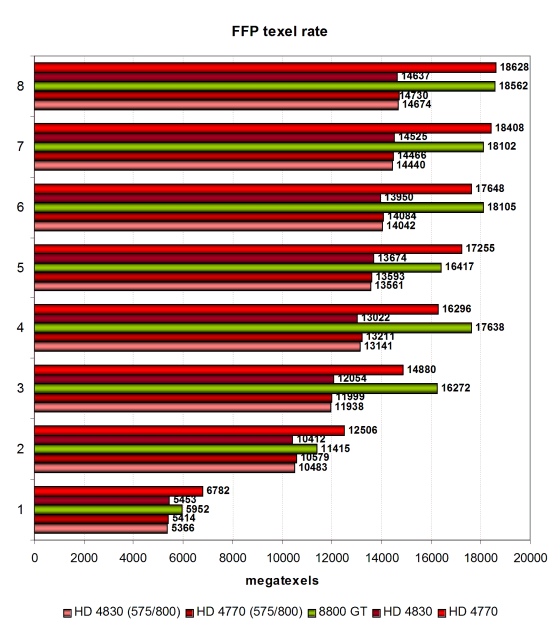 Graphics cards do not reach theoretically possible values, as it usually goes with this slightly outdated test. Results of this synthetic test do not make it to peak values, and all new graphics cards in our test do not reach theoretical maximum. It turns out that RV740 looks up about 25 texels per cycle from 32-bit textures with bilinear filtering, while the theoretical maximum here is 32 texels. But this performance is sufficient for the HD 4770 to keep up with GeForce 9800 GT. The card from NVIDIA is a tad faster only in several cases. But when one or two textures are applied, the graphics card from AMD is apparently more powerful. It demonstrates close results to the HD 4830 operating at the same frequencies, which speaks of identical texture units. But the HD 4770 is much stronger at the nominal frequencies than the HD 4830. Let's have a look at the fill rate results. 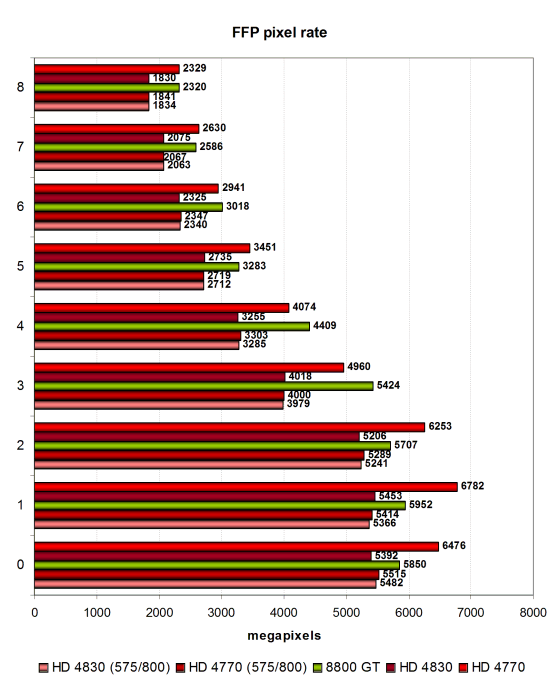 The second synthetic test measures the fill rate. It shows the same situation adjusted for the number of pixels written into the frame buffer. In case of 0, 1, and 2 textures, RADEON HD 4770 demonstrates the highest results, outperforming GeForce 9800 GT. But performance in such modes is limited primarily by memory bandwidth. And the new graphics card from AMD catches up with the old GeForce 9800 GT (aka GeForce 8800 GT) in situations with lots of textures per pixel, except for three and four textures, when it's slightly outperformed. Direct3D 9: pixel shaders testsThe first group of pixel shaders to be reviewed here is too simple for modern GPUs. It includes various versions of pixel programs of relatively low complexity: 1.1, 1.4, and 2.0. 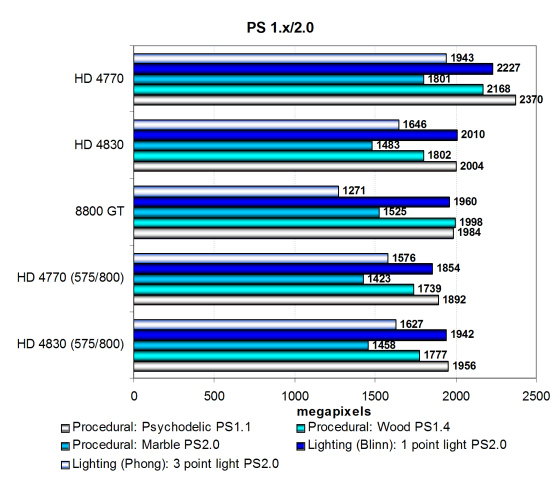 These tests are too easy for modern architectures, even for solutions below $100. They fail to reveal the true GPU power, but they help evaluate the balance between texture lookups and arithmetic operations, especially when architectures change. Performance in these simple tests is limited mostly by the speed of texturing units. However, there was no change of architectures here. And the HD 4770 performs on a par with the card based on the previous GPU (corrected for the difference in their frequencies). RADEON HD 4770 outperforms GeForce 9800 GT in all tests, although a significant performance difference takes place only in the test with three light sources. Comparison between the HD 4770 and HD 4830 operating at the same frequencies shows that the 'old' card is faster in some cases. Perhaps, the new drivers are still balanced for more complex tasks, while simple tasks get less attention. Or it may be the effect of different memory types. However, the difference is not very big. Let's have a look at results in more complex pixel programs of intermediate versions. 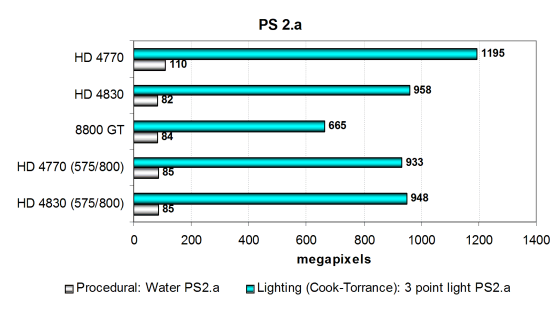 This one is a tad more interesting, although the first test shows the same results as the previous. The procedural water test (which depends much on texturing performance) uses dependent texture lookups of high nesting depth, so the cards line up according to their texel rates, except for a little lag of the card from NVIDIA, which should have been a tad faster here. RV740 demonstrates the maximum result, 30% as high as GeForce 9800 GT. The second test (arithmetic-intensive) apparently favors all AMD architectures with lots of arithmetic units. The new solution from AMD demonstrates the best result in this test, outperforming GeForce 9800 GT and RADEON HD 4830. Operating at the same frequencies, the cards perform almost on a par, but the old model is a tad faster just like the previous time. However, the difference is less than 2%, so we can discard it. Direct3D 9: new pixel shaders testsThese tests of DirectX 9 pixel shaders are even more complex, they are divided into two categories. We'll start with easier shaders - SM 2.0:
There are two modifications of these shaders: arithmetic intensive and texture sampling intensive. Let's analyze arithmetic-intensive modifications, they are more promising from the point of view of future applications. 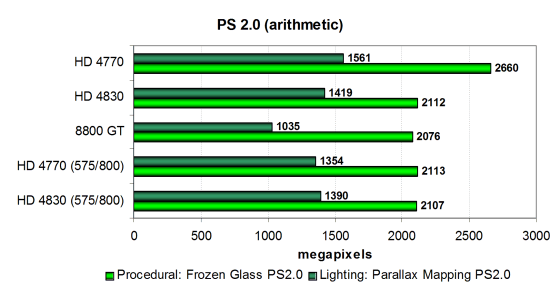 These universal tests depend on the speed of ALUs and texturing, it's the overall GPU balance that matters here. Performance of graphics cards in the Frozen Glass test is limited not only by arithmetic speed, but also by texel rate. This situation is similar to what we have seen in the Water test. The HD 4770 operating at the nominal frequencies outperforms the others by similar values. And the equally-clocked RV740 and RV770LE show the same result. AMD cards have become even faster in the second Parallax Mapping test. The speed of ALUs is more important here than in the previous test. And the HD 4770 is still the fastest solution at nominal frequencies, outperforming the NVIDIA card by 1.5 times. On the whole, the new GPU offers robust texturing and arithmetic performance. Let's analyze results obtained in the texture sampling intensive tests to make sure it's true. 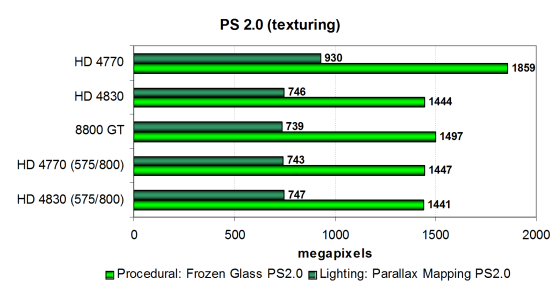 The situation hasn't changed, only GeForce 9800 GT gets higher up, and performance is apparently limited more heavily by texturing. RADEON HD 4770 breaks away from the other cards even further in the first test. The card stands its ground in the second test as well, demonstrating the best results. Relative performance of the HD 4770 and HD 4830 at the same frequencies speaks of totally identical architectures and no problems with fillrate in this test. Let's have a look at results of another two pixel shader tests -- SM 3.0. They are the most complex of all our tests for Direct3D 9 pixel shaders. The tests load ALUs and texture units heavily. Both shader programs are complex, long, and include a lot of branches.
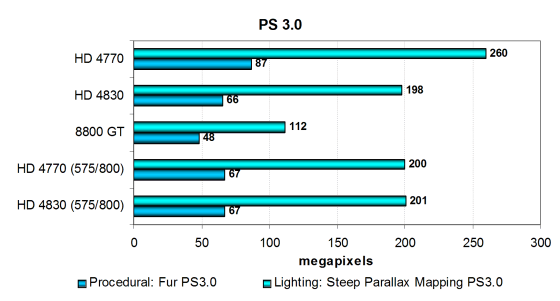 Our readers may remember the time when AMD solutions were outperformed by NVIDIA cards in this test. But the new R7xx architecture offered huge performance gains in PS 3.0 tests. The RV740 proves it, because RADEON HD 4770 is noticeably faster than the other contenders here, especially the card from NVIDIA. GeForce 9800 GT is outperformed by HD 4770 by 1.8 and 2.3 times in two most complex DX9 tests. The new solution from AMD demonstrates the same result as the previous card operating at the same frequencies. The overhauled architecture from AMD again demonstrates excellent results due to many execution units and architectural improvements. Write a comment below. No registration needed!
|
Platform · Video · Multimedia · Mobile · Other || About us & Privacy policy · Twitter · Facebook Copyright © Byrds Research & Publishing, Ltd., 1997–2011. All rights reserved. |